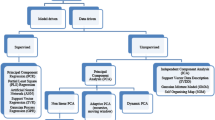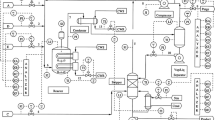Abstract
The article proposes the development of a layered process monitoring strategy based on multi-block kernel principal component analysis (MBKPCA). MBKPCA aids in the development of a distributed process monitoring strategy by taking into account the nonlinear relationships existing amongst the measured characteristics. A distributed process monitoring strategy stratifies the proposed process into a multi-layered structure comprising of blocks, sub-blocks etc. In this article, an MBKPCA-based monitoring strategy was devised for a wire rod manufacturing facility (WRMF) of an integrated steel plant (ISP). The proposed monitoring strategy stratified the entire process into 3 layers, with the first layer comprising the manufacturing stages, the next layer comprising the sub-stages and the third layer comprising the characteristics to be monitored within the respective sub-stages. The detection of the fault was carried out with the aid of kernel principal component analysis (KPCA) score–based Hotelling T2 chart. Fault detection was followed by fault diagnosis, for which new fault diagnostic statistics were proposed which took into account the contribution of the main and the auxiliary characteristics. The study also proposed the concept of cumulative percent contribution ratio (CPCR) to limit the number of parameters (stages/sub-stages/characteristics) that needs to be retained in fault diagnosis.










Similar content being viewed by others
References
Mokhtarname R, Safavi AA, Urbas L, Salimi F, Zerafat MM, Harasi N (2022) Application of multivariable process monitoring techniques to HAZOP studies of complex processes. J Loss Prev Process Ind 74:104674. https://doi.org/10.1016/j.jlp.2021.104674
De-Felipe D, Benedito E (2017) Monitoring high complex production processes using process capability indices. Int J Adv Manuf Technol 93:1257–1267. https://doi.org/10.1007/s00170-017-0591-8
Yang Z, Bose A, Zhong H, Zhang N, **a Q, Kang C (2016) Optimal reactive power dispatch with accurately modeled discrete control devices: a successive linear approximation approach. IEEE Trans Power Syst 32(3):2435–2444. https://doi.org/10.1109/TPWRS.2016.2608178
Hou Z, Liu S (2023) Global algorithm for a class of multiplicative programs using piecewise linear approximation technique. Numer Algorithms 92(2):1063–1082. https://doi.org/10.1007/s11075-022-01330-x
Yan W, Guo P, Li Z (2016) Nonlinear and robust statistical process monitoring based on variant autoencoders. Chemom Intell Lab Syst 158:31–40. https://doi.org/10.1016/j.chemolab.2016.08.00
Bangalore P, Tjernberg LB (2015) An artificial neural network approach for early fault detection of gearbox bearings. IEEE Trans Smart Grid 6(2):980–987. https://doi.org/10.1109/TSG.2014.2386305
Yuan X, Huang B, Wang Y, Yang C, Gui W (2018) Deep learning-based feature representation and its application for soft sensor modeling with variable-wise weighted SAE. IEEE Trans Industr Inf 14(7):3235–3243. https://doi.org/10.1109/TII.2018.2809730
Pilario KE, Shafiee M, Cao Y, Lao L, Yang SH (2019) A review of kernel methods for feature extraction in nonlinear process monitoring. Processes 8(1):24. https://doi.org/10.3390/pr8010024
Lahdhiri H, Taouali O, Elaissi I, Jaffel I, Harakat MF, Messaoud H (2017) A new fault detection index based on Mahalanobis distance and kernel method. Int J Adv Manuf Technol 91:2799–2809. https://doi.org/10.1007/s00170-016-9887-3
Wang J, Liu P, Lu S, Zhou M, Chen X (2023) Decentralized plant-wide monitoring based on mutual information-Louvain decomposition and support vector data description diagnosis. ISA Trans 133:42–52. https://doi.org/10.1016/j.isatra.2022.07.017
Babouri MK, Djebala A, Ouelaa N, Oudjani B, Younes R (2020) Rolling bearing faults severity classification using a combined approach based on multi-scales principal component analysis and fuzzy technique. Int J Adv Manuf Technol 107:4301–4316. https://doi.org/10.1007/s00170-020-05342-6
Song G, Zhang J, Ge Y, Zhu K, Fu Z, Yu L (2022) Tool wear predicting based on weighted multi-kernel relevance vector machine and probabilistic kernel principal component analysis. Int J Adv Manuf Technol 122(5–6):2625–2643. https://doi.org/10.1007/s00170-022-09762-4
Zhang F, Zong S, Ling Z (2017) Fault diagnosis using kernel principal component analysis for hot strip mill. J Eng 9:527–535. https://doi.org/10.1049/joe.2017.0190
Jaffel I, Taouali O, Harkat MF, Messaoud H (2017) Kernel principal component analysis with reduced complexity for nonlinear dynamic process monitoring. Int J Adv Manuf Technol 88:3265–3279. https://doi.org/10.1007/s00170-016-8987-47
Ge Z, Chen J (2015) Plant-wide industrial process monitoring: a distributed modeling framework. IEEE Trans Industr Inf 12(1):310–321. https://doi.org/10.1109/TII.2015.2509247
Jiang Q, Yan X, Huang B (2019) Review and perspectives of data-driven distributed monitoring for industrial plant-wide processes. Ind Eng Chem Res 58(29):12899–12912. https://doi.org/10.1021/acs.iecr.9b02391
Ge Z (2017) Review on data-driven modeling and monitoring for plant-wide industrial processes. Chemom Intell Lab Syst 171:16–25. https://doi.org/10.1016/j.chemolab.2017.09.021
Li Y, Peng X, Tian Y (2020) Plant-wide process monitoring strategy based on complex network and Bayesian inference-based multi-block principal component analysis. IEEE Access 8:199213–199226. https://doi.org/10.1109/ACCESS.2020.3032597
Gao H, Huang W, Gao X, Han H (2023) Decentralized adaptively weighted stacked autoencoder-based incipient fault detection for nonlinear industrial processes. ISA Trans 139:216–228. https://doi.org/10.1016/j.isatra.2023.04.035
Zhou B, Gu X (2020) Multi-block statistics local kernel principal component analysis algorithm and its application in nonlinear process fault detection. Neurocomputing 376:222–231. https://doi.org/10.1016/j.neucom.2019.09.075
Hu Y, Ma H, Shi H (2013) Enhanced batch process monitoring using just-in-time-learning based kernel partial least squares. Chemom Intell Lab Syst 123:15–27. https://doi.org/10.1016/j.chemolab.2013.02.004
Yan W, Wang J, Lu S, Zhou M, Peng X (2023) A review of real-time fault diagnosis methods for industrial smart manufacturing. Processes 11(2):369. https://doi.org/10.3390/pr11020369
Qin SJ, Valle S, Piovoso MJ (2001) On unifying multi-block analysis with application to decentralized process monitoring. Journal of Chemometrics 15(9):715-742. https://doi.org/10.1002/cem.667
Wang X (2012) Fault detection of continuous casting process using kernel PCA. Adv Mater Rese 468:1706–1709. https://doi.org/10.4028/www.scientific.net/AMR.468-471.1706
Zhou P, Zhang R, Liang M, Fu J, Wang H, Chai T (2020) Fault identification for quality monitoring of molten iron in blast furnace iron making based on KPLS with improved contribution rate. Control Eng Pract 97:104354. https://doi.org/10.1016/j.conegprac.2020.104354
Funding
The authors declare that no funds, grants or other support were received during the preparation of this manuscript.
Author information
Authors and Affiliations
Contributions
BKM was responsible for collection of relevant data and its subsequent analysis. AD was involved in the conceptualization of the overall idea and in the preparation of the article.
Corresponding author
Ethics declarations
Competing interests
The authors declare no competing interests.
Additional information
Publisher's Note
Springer Nature remains neutral with regard to jurisdictional claims in published maps and institutional affiliations.
Rights and permissions
Springer Nature or its licensor (e.g. a society or other partner) holds exclusive rights to this article under a publishing agreement with the author(s) or other rightsholder(s); author self-archiving of the accepted manuscript version of this article is solely governed by the terms of such publishing agreement and applicable law.
About this article
Cite this article
Mishra, B.K., Das, A. A 3-layered nonlinear process monitoring strategy with a novel fault diagnosis approach. Int J Adv Manuf Technol 130, 163–176 (2024). https://doi.org/10.1007/s00170-023-12678-2
Received:
Accepted:
Published:
Issue Date:
DOI: https://doi.org/10.1007/s00170-023-12678-2




